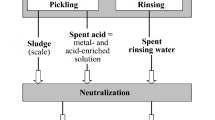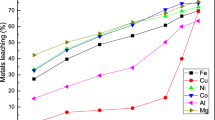Abstract
The stainless steel pickling residue (SSPR) produced from the stainless steel industries in China contains large amounts of heavy metals such as chromium (Cr) and nickel (Ni). The study found that the hexavalent chromium Cr (VI) was the primary contributor to the leaching of Cr in the toxicity character leaching test. A chemical fixation with sodium sulfide was used to treat the SSPR, and the response surface methodology (RSM) was employed to optimize the process. The results revealed that the sodium sulfide dose and curing time had significant effects on the fixation of Cr. The higher was the sodium sulfide dose, and the longer the curing time, the lower the leaching concentration of Cr would be. The water addition amount had insignificant effect when it was higher than 70%. A dose of 1.2% sodium sulfide on dry mass basis, a water addition of 90–100%, and a curing time of longer than 10 days in the open air could reduce the leaching of Cr to below the beneficial use threshold. The low chemical dose and simple procedures established in this study make this treatment method cost-effective for rendering the SSPR into a nonhazardous and useful material.




Similar content being viewed by others
References
Adlan MN, Palaniandy P, Aziz HA (2011) Optimization of coagulation and dissolved air flotation (DAF) treatment of semi-aerobic landfill leachate using response surface methodology (RSM). Desalination 277(1):74–82
Anastasiadou K, Christopoulos K, Mousios E, Gidarakos E (2012) Solidification/stabilization of fly and bottom ash from medical waste incineration facility. J Hazard Mater 207-208:165–170
Anderson MJ, Whitcomb PJ (2000) Design of experiments. Wiley Online Library
Chen S-Y, Lin P-L (2010) Optimization of operating parameters for the metal bioleaching process of contaminated soil. Sep Purif Technol 71(2):178–185
China NEPA (1997) Test method standard for leaching toxicity of solid wastes- Roll over leaching procedure. China National standard GB 5086.1, China National Environmental Protection Administration (NEPA)
China NEPA (2001) Standard for pollution control on the security landfill site for hazardous wastes. China National Standard GB 18598, China National Environmental Protection Administration (NEPA)
China NEPA (2007a) Solid waste-Extraction procedure for leaching toxicity –Sulphuric acid and nitric acid method. China HJ/T 299, China National Environmental Protection Administration (NEPA)
China NEPA (2007b) Identification standards for hazardous wastes- Identification for extraction toxicity. China National Standard GB 5085.3, China National Environmental Protection Administration (NEPA)
China NEPA (2007c) Solid waste-Extraction procedure for leaching toxicity-Acetic acid buffer solution method. China HJ/T 300, China National Environmental Protection Administration (NEPA)
China NEPA (2007d) Environmental protection technical specifications for pollution treatment of the Chromium residue (on trial). China National Standard HJ/T 301, China National Environmental Protection Administration (NEPA)
China NEPA. (2008) Standard for pollution control on the landfill site of municipal solid waste. China National standard GB 16889, China National Environmental Protection Administration (NEPA)
China NEPA (2014) Solid waste-Determination of Hexavalent Chromium by Alkaline digestion/flame atomic absorption spectrophotometic. China HJ/687, China National Environmental Protection Administration (NEPA)
EGC (Environmental Governance in China) (2014) State control to crisis management. Daedalus 143(2):184–197
Hao H, Wang F, Zhang F, Xia M (2013) Synthesis of heavy metal trapping agent, tetrathio bicarbamic acid and its trapping capacity for Cu-containing wastewater. Industrial Water Treatment 33(12):45–48
Hu SH (2005) Stabilization of heavy metals in municipal solid waste incineration ash using mixed ferrous/ferric sulfate solution. J Hazard Mater 123(1):158–164
Ito M, Yoshioka M, Seino Y, Suzuki M, Sakuta M, Maki Y, Kawabata Y (1997) Development of recycling system for sludge from the stainless steel nitric-hydrofluoric acid pickling process. ISIJ Int 37(4):391–398
Karlfeldt FK, Ekberg C, Skarnemark G, Steenari BM (2010) Removal of hazardous metals from MSW fly ash - An evaluation of ash leaching methods. J Hazard Mater 173(1):310–317
Kim HT, Lee TG (2017) A simultaneous stabilization and solidification of the top five most toxic heavy metals (Hg, Pb, As, Cr, and Cd). Chemosphere 178:479–485
Li XM, Zhao JX, Cui YR, Yang J (2009) The comprehensive utilization of EAF dust and pickling sludge of stainless steel works. Mater Sci Forum 60-622:603–606
Li XM, Xie G, Hojamberdiev M, Cui YR, Zhao JX (2014) Characterization and recycling of nickel and chromium-contained pickling sludge generated in production of stainless steel. J Cent South Univ 21(8):3241–3246
Lindblom B, Ma P (1999) Characterisation and reduction studies of the waste pickling sludge of stainless steel. Proceedings of Global Symposium on Recycling, Waste Treatment and Clean Technology. pp. 1493–1501
Liu PY, Tan DS, Ding WZ (2017) A study on leaching heavy metals from stainless steel pickling sludge. Nonferrous Metal Materials and Engineering 38(3):149–153 (In Chinese)
Ma P, Lindblom B, Björkman B (2005) Experimental studies on solid- state reduction of pickling sludge generated in the stainless steel production. Scand J Metall 34(1):31–40
Nonhazardous Solid Waste Corrective Action Trust Fund Regulations. Mississippi Department of Environmental Quality (MDEQ) Office of Pollution Control, 11 Miss. Admin. Code Pt. 4 Ch. 6
Nowak B, Rocha SF, Aschenbrenner P, Rechberger H, Winter F (2012) Heavy metal removal from msw fly ash by means of chlorination and thermal treatment: influence of the chloride type. Chem Eng J 179(none):178–185
Quina MJ, Bordado JCM, Quinta-Ferreira RM (2014) Stabilisation/solidification of APC residues from MSW incineration with hydraulic binders and chemical additives. J Hazard Mater 264:107–116
Rai D, Eary LE, Zachara JM (1989) Environmental chemistry of chromium. Sci Total Environ 86(1):15–23
Razzell W (1990) Chemical fixation, solidification of hazardous waste. Waste Manag Res 8(2):105–111
Shojaeimehr T, Rahimpour F, Khadivi MA, Sadeghi M (2014) A modeling study by response surface methodology (RSM) and artificial neural network (ANN) on Cu2+ adsorption optimization using light expended clay 420 aggregate (LECA). J Ind Eng Chem 20(3):870–880
Singhal A, Tewari VK, Prakash S (2008) Characterization of stainless steel pickling bath sludge and its solidification/stabilization. Build Environ 43(6):1010–1015
Sukandar PT, Tanaka M, Aoyama I (2009) Chemical stabilization of medical waste fly ash using chelating agent and phosphates: heavy metals and ecotoxicity evaluation. Waste Manag 29(7):2065–2070
Sun T, Chen J, Lei X, Zhou C (2014) Detoxification and immobilization of chromite ore processing residue with metakaolin-based geopolymer. J Environ Chem Eng 2(1):304–309
Sun Y, Watanabe N, Qiao W, Gao X, Wang W, Zhu T (2010) Polysulfide as a novel chemical agent to solidify/stabilize lead in fly ash from municipal solid waste incineration. Chemosphere 81(1):120–126
Uncu ON, Cekmecelioglu D (2011) Cost-effective approach to ethanol production and optimization by response surface methodology. Waste Manag 31(4):636–643
USEPA (1992a) Toxicity characteristic leaching procedure. U.S. Environmental Protection Agency Standard Method 1311
USEPA (1992b) Acid Digestion of Aqueous Samples and Extracts for Total Metals for Analysis by FLAA or ICP Spectroscopy. U.S. Environmental Protection Agency Standard Test Method 3010A
USEPA (1996) Acid digestion of sediments, sludges, and soils. US Environmental Protection Agency Standard Method 3050B
USEPA (2004) Soil and waste pH. U.S. Environmental Protection Agency Standard Method 9045D
Wang FH, Zhang F, Chen YJ, Gao J, Zhao B (2015) A comparative study on the heavy metal solidification/stabilization performance of four chemical solidifying agents in municipal solid waste incineration fly ash. J Hazard Mater 300:451–458
Weibel G, Eggenberger U, Schlumberger S, Mäder UK (2017) Chemical associations and mobilization of heavy metals in fly ash from municipal solid waste incineration. Waste Manag 62:147–159
Yao J, Kong Q, Zhu H, Long Y, Shen D (2013) Content and fractionation of cu, zn and cd in size fractionated municipal solid waste incineration bottom ash. Ecotoxicol Environ Saf 94(1):131–137
Zhang B, Zhou W, Zhao H, Tian Z, Li F, Wu Y et al (2016) Stabilization/solidification of lead in mswi fly ash with mercapto functionalized dendrimer chelator. Waste Manag 50:105–112
Zhang S, Jiang X, Liu B, Lv G, Jin Y, Yan J (2017) Co-combustion of bituminous coal and pickling sludge in a drop-tube furnace: thermodynamic study and experimental data on the distribution of Cr, Ni, Mn, As, Cu, Sb, Pb, Cd, Zn, and Sn. Energy Fuel 31(3):3019–3028
Zhou H, Long YQ, Meng AH, Li QH, Zhang YG (2015) Classification of municipal solid waste components for thermal conversion in waste-to-energy research. Fuel 145:151–157
Acknowledgments
The authors thank Professor Fengxiang Han at Jackson State University, MS, USA, and Professor Stan Galicki at Millsaps College, MS, USA for their assistance in XRD analysis of the samples.
Funding
This research was jointly funded by the Tsinghua University Graduate School in Shen Zhen, China, and the Jackson State University, USA, through a collaborative effort.
Author information
Authors and Affiliations
Corresponding author
Additional information
Responsible editor: Philippe Garrigues
Publisher’s note
Springer Nature remains neutral with regard to jurisdictional claims in published maps and institutional affiliations.
Rights and permissions
About this article
Cite this article
Su, P., Li, Y., Zhang, J. et al. Characterization and chemical fixation of stainless steel pickling residue using sodium sulfide hydrate. Environ Sci Pollut Res 26, 10240–10250 (2019). https://doi.org/10.1007/s11356-019-04500-y
Received:
Accepted:
Published:
Issue Date:
DOI: https://doi.org/10.1007/s11356-019-04500-y




